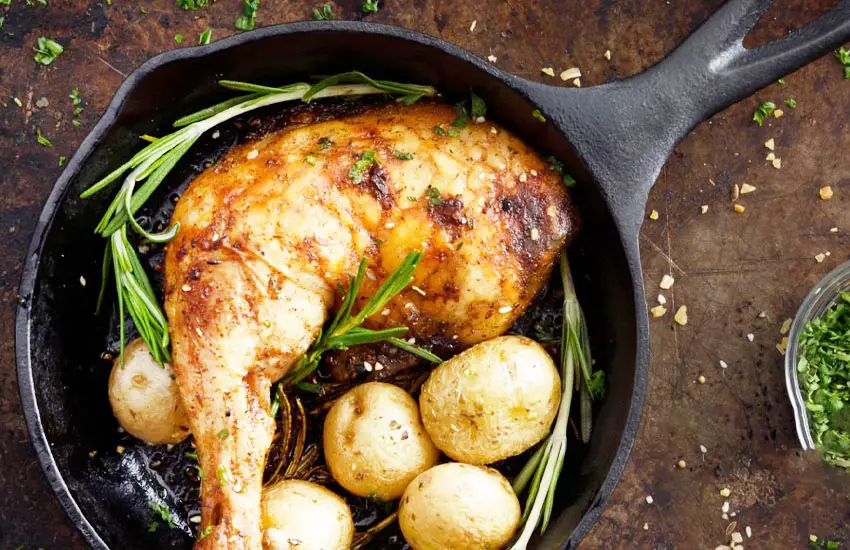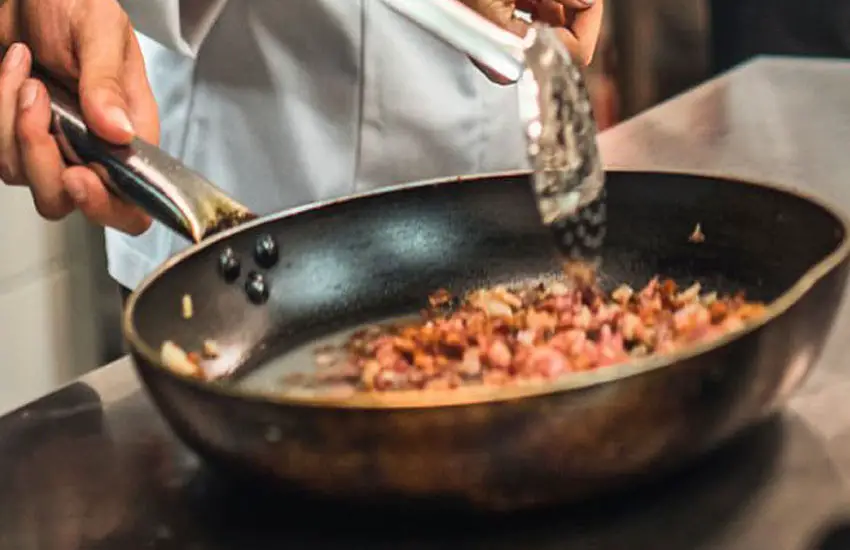As an Amazon Associate, I earn from qualifying purchases at no extra cost to you.
6 Simple Skillet Techniques for Easy Cooking
Skillets are versatile kitchen tools that can be used for a wide range of dishes, from sautéing vegetables to frying chicken. Whether you’re a beginner or a seasoned cook, mastering these techniques will help you create delicious meals with minimal effort.
In this blog post, we’re going to explore six simple skillet techniques that will make cooking easy and enjoyable. We’ll cover everything from basic sautéing to more advanced techniques like deglazing and braising.

6 Foolproof Skillet Techniques for Effortless Cooking
Cooking with skillets can be a breeze with the right techniques. Whether you’re a beginner or an experienced cook, mastering these easy methods will help you whip up delicious meals in no time.
1. Sauteing
Sauteing is like cooking on fast-forward. You toss small pieces of food in a hot skillet with a little oil or butter and cook them quickly over high heat.
It’s perfect for veggies like bell peppers, onions, and mushrooms, as well as thinly sliced meats like chicken breast or beef strips. Just make sure your skillet is nice and hot before you add the ingredients, and keep them moving around the pan to prevent sticking or burning.
2. Pan-Frying
Pan-frying takes sauteing to the next level by using more oil or fat. You want enough oil to cover about halfway up the food you’re cooking, whether it’s chicken cutlets, fish fillets, or even tofu slices.
This method creates a crispy exterior while keeping the inside moist and tender. Just be careful not to overcrowd the skillet, or your food won’t cook evenly. And remember to flip your food halfway through cooking to ensure even browning on both sides.
3. Deglazing
Deglazing is a fancy way of saying “scrape up all the tasty bits stuck to the bottom of the pan.” After cooking meat or veggies in a skillet, there are often flavorful browned bits left behind.
To capture all that goodness, simply add a splash of liquid to the hot pan, like broth, wine, or even just water, and use a spatula to scrape up any stuck-on bits. This creates a flavorful base for sauces, gravies, or pan sauces to drizzle over your cooked food.
4. Braising
Braising is a slow-cooking technique that’s perfect for tougher cuts of meat that need a little extra love. Start by browning the meat in a hot skillet to develop flavor, then add some liquid, like broth or wine, cover the skillet, and let it simmer gently until the meat is tender and juicy.
This method works wonders for cuts like beef chuck, pork shoulder, or chicken thighs, turning them into melt-in-your-mouth masterpieces.
5. One-Pan Meals
One-pan meals are a busy cook’s best friend. With just one skillet, you can cook an entire meal in one go, minimizing cleanup and maximizing flavor.
Start by browning your protein of choice, whether it’s chicken, sausage, or tofu, then add veggies, grains, and sauces to the same skillet and let everything cook together until it’s done. You can get creative with combinations like chicken and broccoli stir-fry, sausage and peppers with rice, or tofu and vegetable curry.
6. Frying
Frying is all about cooking food in hot oil until it’s crispy and golden brown. You can deep-fry, which means completely submerging the food in oil, or shallow-fry, which means cooking it in a smaller amount of oil and flipping it halfway through cooking.
Either way, the key is to get the oil nice and hot before you add the food, so it cooks quickly and doesn’t absorb too much oil. Just be sure to use a skillet with high sides to contain any splatters, and always keep an eye on the temperature to prevent burning.
Tips for Success
Now that you know some basic skillet techniques, here are a few tips to help you get the best results every time:
- Preheat your skillet before adding food to ensure even cooking and prevent sticking.
- Use the right type of skillet for the job, whether it’s stainless steel, non-stick, or cast iron.
- Don’t overcrowd the skillet, or your food won’t cook evenly. Cook in batches if necessary.
- Keep an eye on the heat and adjust as needed to prevent burning or overcooking.
- Experiment with different flavor combinations and ingredients to keep things interesting.
- And most importantly, don’t be afraid to get creative and have fun in the kitchen!
With these easy cooking techniques and a little practice, you’ll be a skillet superstar in no time. So grab your favorite skillet and get cooking!
What to Use If You Don’t Have a Skillet
If you don’t have a skillet, don’t worry! There are other things you can use to cook delicious meals. Here are some easy options:

1. Non-Stick Pan
If you have a non-stick pan, you can use it instead of a skillet. Non-stick pans have a special coating that helps prevent food from sticking, making them great for cooking eggs, pancakes, or sautéing veggies.
2. Frying Pan
A frying pan is similar to a skillet but has slightly sloped sides. It’s perfect for frying foods like bacon or making stir-fries. Just be careful not to overcrowd the pan, or your food won’t cook evenly.
3. Saucepan
While saucepans are typically used for making sauces or boiling liquids, you can also use them to cook certain foods that would normally be cooked in a skillet. For example, you can sauté vegetables or sear meat in a saucepan, although the taller sides might make flipping or stirring a bit trickier.
4. Dutch Oven
Dutch ovens are heavy pots with tight-fitting lids, usually made of cast iron or enamel-coated cast iron. While they’re great for slow-cooking stews or braising meats, you can also use them as a makeshift skillet. Just make sure to preheat the Dutch oven before adding ingredients, and be mindful of the higher sides when flipping or stirring.
5. Griddle
A griddle is a flat cooking surface, often made of cast iron or non-stick material, that’s typically used for cooking pancakes, grilled cheese sandwiches, or even burgers. While it’s not quite the same as a skillet, you can still use a griddle to cook many of the same foods.
6. Wok
If you have a wok, you can use it to cook a wide variety of dishes, from stir-fries to fried rice. Woks are designed to distribute heat evenly across the bottom and sides, making them great for quick-cooking meals over high heat.
7. Baking Sheet
While not ideal for cooking foods that require flipping or stirring, a baking sheet can be used as a makeshift skillet for roasting vegetables or baking proteins like chicken or fish. Just be sure to use a sheet with raised edges to contain any juices or oil.
8. Grill
If you have access to an outdoor grill or a stovetop grill pan, you can use it to cook many of the same foods you would normally cook in a skillet. Grilling adds delicious smoky flavor to meats, veggies, and even fruits.
9. Microwave
While it won’t give you the same results as cooking on the stove, you can use a microwave to cook certain foods that would normally be cooked in a skillet. For example, you can microwave vegetables or heat up pre-cooked proteins like chicken or sausage.
10. Slow Cooker
While not suitable for quick-cooking meals, a slow cooker can be used to cook many of the same foods you would normally cook in a skillet, like stews, soups, or braised meats. Just plan ahead, as cooking times in a slow cooker are much longer.
So, even if you don’t have a skillet, there are plenty of other options you can use to cook delicious meals. Just be creative and use what you have on hand!
